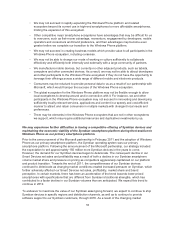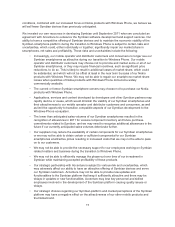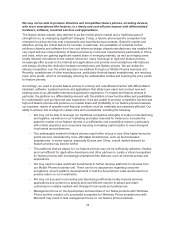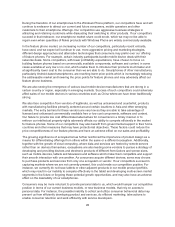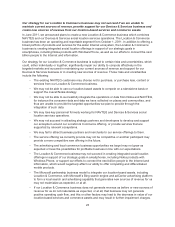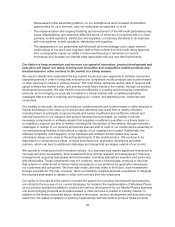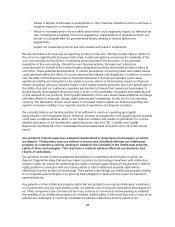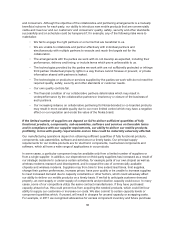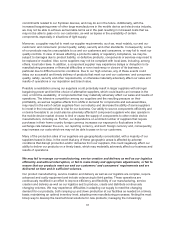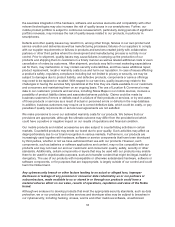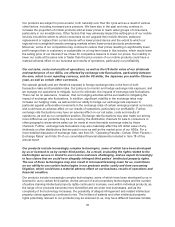Nokia 2011 Annual Report Download - page 28
Download and view the complete annual report
Please find page 28 of the 2011 Nokia annual report below. You can navigate through the pages in the report by either clicking on the pages listed below, or by using the keyword search tool below to find specific information within the annual report.with Windows Phone. For example, we may not be successful in changing our mode of working to
collaborate effectively and efficiently with Microsoft, or be able to develop the necessary infrastructure
to manufacture Nokia products with Windows Phone, source the right chipsets and generally integrate
the hardware and software that both we and Microsoft are contributing.
Failures or delays in understanding or anticipating market trends or delays in innovation, product
development and execution may result in a suboptimal portfolio of mobile products and location-based
or other services, gaps in certain price points or an uncompetitive offering. Our failure to deliver mobile
products in a timely fashion to markets and in sufficient quantities not only may have a negative effect
on our market share, net sales and profitability, but may also erode our brand through consumer
disappointment. Moreover, our customers and consumers expect that the services and applications
provided with and in connection with our mobile products are positively differentiated from our
competitors’ offerings, have the same or more capabilities than those of our competitors, function
properly and are of high quality. If we fail in launching the services, have insufficient breadth of
available applications or content, have inadequate or unsuccessful updates to them or there are other
defects or quality issues with our mobile products, including the operating platform, software and user
interface, this may cause consumer retention and engagement for our mobile products to deteriorate.
Additionally, we may not be able to ensure that our products, especially Nokia products with Windows
Phone, will be offered and recommended to consumers at the point of sale, due to, for instance,
inadequate sales incentives, training of sales personnel, marketing support, and experience in
generating interest for a new and relatively unfamiliar Windows Phone smartphone in an otherwise
highly competitive market. This could result in low sales and potentially delay ramp-up and give more
momentum to competitors impacting the success of our smartphone strategy with Nokia products with
Windows Phone.
Our sales and profitability are dependent on the development of the mobile and
communications industry, including location-based and other services industries, in numerous
diverse markets, as well as on general economic conditions globally and regionally.
Our sales and profitability are dependent on the development of the mobile and fixed communications
industry in numerous diverse markets in terms of the number of new mobile subscribers, the number of
existing subscribers who upgrade or replace their existing mobile devices and the number of active
users of applications and services on our devices. In certain low penetration markets, in order to
support a continued increase in mobile subscribers, we continue to be dependent on our own and
mobile network operators’ and distributors’ ability to increase the sales volumes of lower cost mobile
devices and on mobile network operators to offer affordable tariffs and tailored mobile network
solutions designed for a low total cost of ownership. In highly penetrated markets, we are more
dependent on our own and mobile network operators’ ability to successfully introduce value-added
products, such as smartphones that drive the upgrade and replacement of devices, as well as
ownership of multiple devices. We are also dependent on developers’ interest and success in creating
value-added applications and other content in our products to achieve differentiation and additional
consumer demand.
Our location-based and other services business is dependent on the development of a wide variety of
products that use its data, the availability and functionality of such products and the rate at which
consumers and businesses purchase those products. Nokia Siemens Networks is dependent on the
pace of investments made by mobile network operators and service providers in network infrastructure
and related services. If we and the other market participants are not successful in our attempts to
increase subscriber numbers, stimulate increased usage or drive upgrade and replacement sales of
mobile devices and develop and increase demand for value-added services, or if mobile network
operators and service providers invest in the related infrastructure and services less than anticipated,
our business and results of operations could be materially adversely affected.
26


